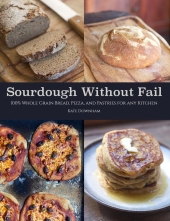posted 3 years ago
My son's friend brought me sourdough rye babies from Norway about 5 years ago. I've read that local yeast will have replaced the Norwegian yeast by now, but who knows - maybe they've mutated in a mutually beneficial way.
I'd had a wheat sourdough starter before and found it troublesome, so I decided to try a different approach. I use a wide mouth 1 liter jar with heavy plastic on the top held with an elastic band. I keep it in the fridge and try to make sure I use it at least once every 2 weeks. When I get it out of the fridge, I add 1/4 cup of rye flour and 1/4 cup of our well water (read, no chlorine or chloramines to tick them off). I read that yeast can double in 3 hours or so, so if I'm in a rush, I will add another 1/4 each of rye flour and water at that point, but usually, I try to leave it most of the day before feeding it a second time.
I use the "no-knead" technique and the "stir it up and let it alone" system.
So I lightly butter a mixing bowl that will hold it through the rise and then mix in the bowl:
2 3/4 cups unbleached flour
1/4 cup wheat germ
1/4 cup rye flour
1/2 cup whole wheat flour
1 tsp salt
(if you're in a rush you may mix in 1/4 tsp bread yeast but it's not necessary if you're going to let it rise overnight)
Then I pour 1 cup of the sourdough starter out of its bottle into my two cup measure.
I then add warm water to the measuring cup until it reaches the two cup mark and stir gently to dilute the starter.
Then I gradually add the water/starter mix into the flour mix stirring with a rubber spatula in a "folding over" sort of action. Normally, I will need at least an extra 1/4 cup extra of water, because I'm looking for "gloppy". It's hard to describe, but as Stacy Witscher said, "the key to a good loaf is a wet, no knead style dough."
Then I put a plate over the bowl to keep it moist and let it rise overnight. Normally, I'm getting approximately a 12 hour rise.
Next I put my round glazed cast-iron Dutch oven in the oven with its lid on the rack beside it, turn the oven on at 425F and set a timer for 30 min. After 30 min, I lift out the pan carefully, use a wet spatula to loosen the dough from it's bowl "pouring" if you think in terms of a slow moving ooze that needs a certain amount of pushing into the hot pan, put the hot lid on it and put it back in the oven as quickly as possible. I set the timer for another 30 min. At that time, I reduce the temperature to 350F and remove the lid. Five minutes like this will crisp up the top. If the dough was wetter, it may need a bit more, but I tap it to tell if it's done.
I tip it right out of the Dutch oven onto a cooling rack. If it doesn't slide out, that's a sign that the oven temp isn't quite right (not all ovens read the same).
This doesn't meet the "whole grain" requirement, but possibly if you start at this ratio, you might find ways to move up as time goes on. This isn't the only bread I make (I regularly make a 75% whole wheat bread in my bread machine) - it's more of a "special" day bread, but my friends will eat it and they're much fussier than my family. It was based on a recipe that used only white flour which I found boring. I've been tweaking it for years now and at least if has flavour and is popular. I've debated subbing in more rye flour, but it is lower in gluten so there's some risk there.

 3
3




 4
4




 2
2




 5
5




 3
3




 1
1




 2
2




 1
1










